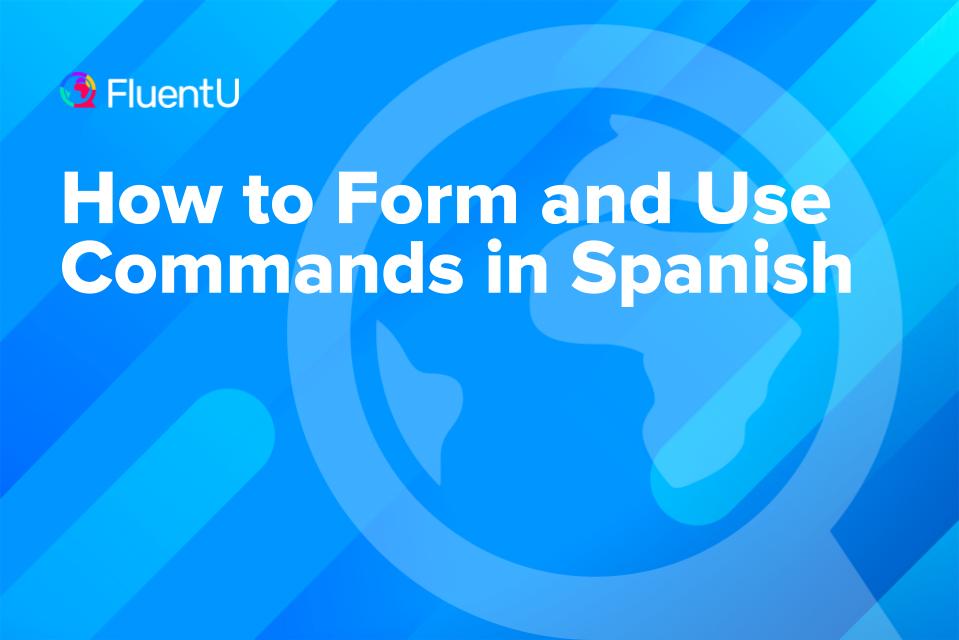Contents
How to Form and Use Commands in Spanish

Spanish commands are an important part of learning the language. We use them to give directions or instructions, to ask for things, to give warnings or advice and more.
If you’re already familiar with a couple of Spanish tenses, learning commands should be a breeze.
Download: This blog post is available as a convenient and portable PDF that you can take anywhere. Click here to get a copy. (Download)
Using the Imperative Mood for Spanish Commands
Spanish has three grammatical moods: the indicative, the subjunctive and the imperative. The imperative mood is used to give commands. In other words, it’s used to tell someone what to do.
In English, the imperative consists of the base form of the verb. For example, “Listen!” or “Tell me!” You could give these commands to one or more people.
Commands in Spanish, however, have different endings depending on who you’re talking to. They normally don’t include a subject, but usually refer to the second person singular or plural.
Here are the endings for the three different verb types in the imperative mood, along with examples using hablar (to speak), comer (to eat) and escribir (to write):
| Pronoun | -ar verbs | -er verbs | -ir verbs |
|---|---|---|---|
| Tú | -a (habla) | -e (come) | -e (escribe) |
| Usted | -e (hable) | -a (coma) | -a (escriba) |
| Nosotros | -emos (hablemos) | -amos (comamos) | -amos (escribamos) |
| Vosotros | -ad (hablad) | -ed (comed) | -id (escribid) |
| Ustedes | -en (hablen) | -an (coman) | -an (escriban) |
Forms of the Spanish Imperative
Informal Spanish Commands
We use affirmative commands in the tú form to tell just one person to do something in informal settings.
Affirmative tú commands use the él/ella/usted form of the present simple indicative. To make the negative command, we use the word no followed by the verb in the tú subjunctive form.
| Infinitive Verb | Affirmative Tú Command | Negative Tú Command |
|---|---|---|
| hablar (to speak) | habla (speak) | no hables (don't speak) |
| comer (to eat) | come (eat) | no comas (don't eat) |
| escribir (to write) | escribe (write) | no escribas (don't write) |
Take a look at some example sentences:
Abre la puerta. (Open the door.)
Come las verduras. (Eat the vegetables.)
No vayas al parque. (Don’t go to the park).
No comas dulces en la mañana. (Don’t eat candy in the morning.)
For more on telling someone what not to do, check out our full post on negative commands in Spanish.
There are only eight irregular tú commands. They are:
| Infinitive | Tú Command | Example Sentences |
|---|---|---|
| decir (to say/tell) | di | Dime todo lo que pasó. (Tell me everything that happened.) |
| hacer (to do/make) | haz | Haz tu tarea ahora. (Do your homework now.) |
| ir (to go) | ve | Ve al mercado, por favor. (Go to the market, please.) |
| poner (to put/place) | pon | Pon la comida en la mesa, por favor. (Put the food on the table, please.) |
| salir (to leave/go out) | sal | Sal esta noche conmigo. (Go out with me tonight.) |
| ser (to be) | sé | Sé un buen niño. (Be a good boy.) |
| tener (to have) | ten | ¡Ten cuidado! (Be careful!) |
| venir (to come) | ven | ¡Ven acá! (Come here!) |
Formal Spanish Commands
We use commands in the usted form to tell someone what to do in more formal settings or to imply respect.
To make an usted command, use the él/ella/usted form of the present simple subjunctive. In most cases, this means we take the yo form of the verb, drop the – o and add the opposite ending. To make it negative, we just add the word no:
| Infinitive Verb | Affirmative Usted Command | Negative Usted Command |
|---|---|---|
| hablar (to speak) | hable (speak) | no hable (don't speak) |
| comer (to eat) | coma (eat) | no coma (don't eat) |
| escribir (to write) | escriba (write) | no escriba (don't write) |
For example:
Sólo hable español conmigo, por favor. (Only speak Spanish with me, please.)
Dígame el plan. (Tell me the plan.)
No salga hasta la noche. (Don’t leave until tonight.)
No vea la película antes de leer el libro. (Don’t watch the movie before reading the book.)
There are also some usted commands that don’t follow the traditional format:
| Infinitive | Usted Command | Example Sentences |
|---|---|---|
| dar (to give) | dé | Déme la ensalada con pollo, por favor. (Give me the chicken salad, please.) |
| decir (to say/tell) | diga | Dígame su nombre y número de teléfono. (Tell me your name and phone number.) |
| estar (to be) | esté | Esté atento a las instrucciones. (Pay attention to the instructions.) |
| hacer (to do/make) | haga | No haga planes antes de consultar el pronóstico del tiempo. (Don't make plans before checking the weather forecast.) |
| ir (to go) | vaya | Vaya al médico. (Go to the doctor.) |
| poner (to put/place) | ponga | Ponga el formulario en un sobre. (Put the form in an envelope.) |
| saber (to know) | sepa | Sepa que estamos aquí para ayudarlo. (Know that we're here to help you.) |
| salir (to leave/go out) | salga | Salga por la puerta trasera. (Leave through the back door.) |
| ser (to be) | sea | Por favor sea puntual. (Please be on time.) |
| tener (to have) | tenga | Tenga cuidado, la acera está resbaladiza. (Be careful, the sidewalk is slippery.) |
| venir (to come) | venga | Venga conmigo. (Come with me.) |
Ustedes Commands
In Latin America, you’d use ustedes commands to address more than one person simultaneously (formal or informal). In Spain, we use ustedes only in formal situations.
To make the ustedes form of these commands, just add an n to the usted form.
Vayan a la tienda y compren ropa nueva. (Go to the store and buy new clothes.)
Escriban sus nombres en el formulario. (Write your names on the form.)
Like with usted, ustedes negative commands are the same as their affirmative counterparts, just preceded by the word “no.”
No coman eso. (Don’t eat that.)
No jueguen en la calle. (Don’t play in the street.)
There are a few other types of commands that we won’t cover here but are covered elsewhere. Check out our posts on:
- Vos commands (used in many regions throughout Latin America.)
- Vosotros commands (used in Spain)
- Nosotros commands (used to suggest a group activity, like saying “Let’s…” in English)
Spanish Commands with Reflexive Verbs
Reflexive verbs are used for actions that someone does to themselves. As a quick reminder, the reflexive pronouns are:
Yo → me
Tú → te
Él/ella/usted → se
Nosotros → nos
Vosotros → os
Ellos/ellas/ustedes → se
To make a command out of a reflexive verb, conjugate the verb as usual and then stick the reflexive pronoun on the end of the word. For example, to tell someone to wash their hands (lavarse las manos), you would say:
¡Lávate las manos! (Wash your hands!)
Spanish Commands with Object Pronouns
As you may know, object pronouns can either be direct or indirect. The direct object directly receives the action of the verb, and an indirect object indirectly receives the action of the verb.
To use Spanish commands with indirect and direct object pronouns, we just stick them onto the ending of the command.
When commands call for both an indirect and a direct object pronoun, the indirect object always comes before the direct object. To remember the order of Spanish pronouns, use the acronym RID—Reflexive, Indirect, Direct.
Llámala pronto. (Call her soon.)
Dímelo. (Tell it to me.)
Llévaselo a tu mamá. (Take it to your mom.)
Tráemelos. (Bring them to me.)
How to Make Polite Commands in Spanish
Conjugating verbs in the forms we’ve seen above—known as the mandato form—is a good way to express that you want someone to do something (or not).
But in some social situations, using a command may feel a little too direct or aggressive. There are a few other, gentler ways to ask someone to do something in these situations:
- Use the conditional tense: In addition to expressing hypotheticals, the Spanish conditional tense can also serve as a polite way to make requests. For example, instead of saying Préstame tu libro (Lend me your book), you could say ¿Me prestarías tu libro? (Would you lend me your book?)
- Use the verb poder and an infinitive: In a question, puedes means “can you.” So instead of saying Saca la basura (Take out the trash), you can ask ¿Puedes sacar la basura? (Can you take out the trash?)
- Use the present simple like a question: This one might not be in any grammar books, but I hear Spanish speakers do it all the time. Instead of saying Pásame la sal (Pass the salt) for example, you could say ¿Me pasas la sal?
- Use the infinitive verb: You’ll often see this form when the command is directed to the general public, such as on signs ( No fumar — No smoking), or when giving step-by-step instructions, such as in a recipe ( Mezclar la harina y la mantequilla — Mix the flour and butter.)
While you can certainly study when to use Spanish commands, the best way to learn when the different forms are appropriate is by observing native speakers.
If you’ve ever watched a telenovela or Spanish movie, I’m sure you’ve heard a handful of Spanish commands. You’ll also find an abundance of them when using an online immersion program like FluentU.
FluentU takes authentic videos—like music videos, movie trailers, news and inspiring talks—and turns them into personalized language learning lessons.
You can try FluentU for free for 2 weeks. Check out the website or download the iOS app or Android app.
P.S. If you decide to sign up now, you can take advantage of our current sale!

Quiz on Spanish Commands
Now that we’ve gone over how to form commands in Spanish, it’s time to test your knowledge! Take the quiz below and just refresh the page if you want to start over or retake it.
Spanish commands are useful for learners at all levels and can be used in various social situations.
Plus, practicing the mandato form forces you to brush up on your present simple indicative and subjunctive conjugations, which is great practice for beginners.
So, get studying (¡ponte a estudiar!) and you’ll have Spanish commands down in no time.
Download: This blog post is available as a convenient and portable PDF that you can take anywhere. Click here to get a copy. (Download)
And One More Thing…
If you've made it this far that means you probably enjoy learning Spanish with engaging material and will then love FluentU.
Other sites use scripted content. FluentU uses a natural approach that helps you ease into the Spanish language and culture over time. You’ll learn Spanish as it’s actually spoken by real people.
FluentU has a wide variety of videos, as you can see here:

FluentU brings native videos within reach with interactive transcripts. You can tap on any word to look it up instantly. Every definition has examples that have been written to help you understand how the word is used. If you see an interesting word you don’t know, you can add it to a vocab list.

Review a complete interactive transcript under the Dialogue tab, and find words and phrases listed under Vocab.

Learn all the vocabulary in any video with FluentU’s robust learning engine. Swipe left or right to see more examples of the word you’re on.

The best part is that FluentU keeps track of the vocabulary that you’re learning, and gives you extra practice with difficult words. It'll even remind you when it’s time to review what you’ve learned. Every learner has a truly personalized experience, even if they’re learning with the same video.
Start using the FluentU website on your computer or tablet or, better yet, download the FluentU app from the iTunes or Google Play store. Click here to take advantage of our current sale! (Expires at the end of this month.)







